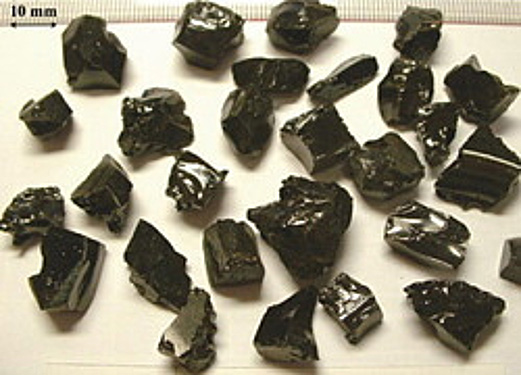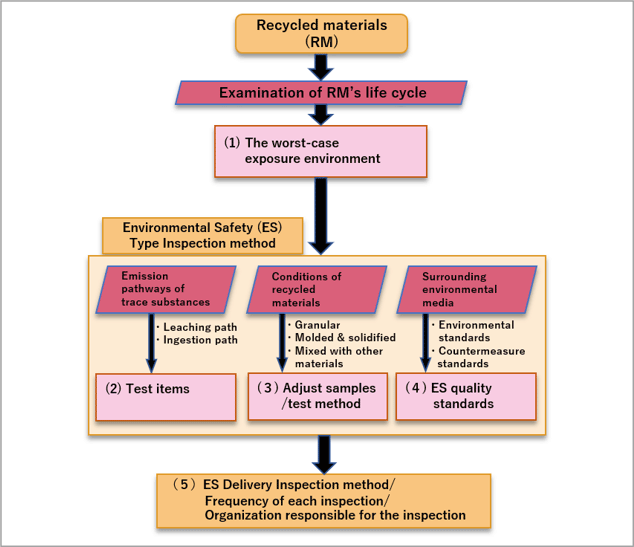- Waste management in Japan
- Circular economy in Japan
- Waste management in Asia
- Disaster waste management
Environmental Safety Quality of Recycled Materials
Sound Material-Cycle Society already established?
We live and work in buildings, walk on the road, use products consisting of metals and various other materials, use electricity, and produce waste. Renovation of buildings and roads transforms some old structures into waste concrete and concrete asphalt. During metal fabrication process, steel slag is generated as a by-product. Electric power plants generate coal ash also as a by-product. Burning and melting household and business waste (municipal solid waste, MSW) generates MSW ash and MSW slag (see the November 2006 issue [in Japanese]).
Application of these by-products, or "recycled materials," as a substitute for soil, sand and rocks can reduce the need for their excavation and cutting of mountains, and can minimize environmental damage. The use of recycled materials can also reduce the amount of waste that goes to waste landfill sites whose expansion is extremely difficult.
The total amount of all the above-mentioned by-products, from waste concrete to MSW ash, reaches about 120 million tons per year. In contrast, the total amount of waste that goes to the waste landfill sites, including the types of waste not listed above, is only about 20 million tons per year. This means that most of the waste is already turned into recycled materials and utilized in our daily lives. Therefore, I believe that Sound Material-Cycle Society has been almost established, in terms of the reduction of waste amount.

To secure the reliability of recycled materials
Is it really safe to keep using recycled materials in our society? Some of them should be disposed of if they are no longer usable. However, we clearly don't have enough sites for disposing of all the waste. So, if the recycled materials lose reliability in their use, they will have no place to go. In order to avoid this critical situation, we must build a system that will assure the safety of recycled materials so that we can fully answer the above-mentioned question.
Environmental Safety Quality (ESQ) is an important requirement for this assurance system. I once wrote an article on the ESQ of recycled materials (see the April 16, 2007 issue [in Japanese]). This article will introduce the results of our six years of research and activity on this topic since then.
What will constitute the most appropriate ESQ for recycled materials? How should the ESQ requirements be determined? As mentioned earlier, there are various recycled materials, and their utilizations also differ widely such as land development and brick production. Yet, different recycled materials may be utilized for the same purpose if they have similar physical and mechanical properties. It means that the ESQ system for recycled materials should consider certain points that are common to them all.
ESQ requirements for recycled materials
Now, I will introduce five main points/steps that are considered important and common to various recycled materials. I will elaborate each of them before providing a summary at the end.
Suppose that a recycled material such as slag is used as aggregate for concrete after it has passed the ESQ inspection. This concrete may be demolished and may be used as a roadbed material in the future. This indicates that a recycled material may be utilized for different purposes at different stages of its life cycle. It leads to the idea that ESQ of a recycled material should be developed based on the potentially most dangerous usage environment (or "the worst-case exposure environment").
The second step concerns which tests need to be conducted. For this, we examine possible emission pathways of hazardous substances in the worst-case exposure environment, including their release paths from the recycled material and possible human intake. The emission pathways are mainly categorized into two: "leaching path" where the toxins leach into groundwater and a person drinks the contaminated water from a well, and "ingestion path" where the toxins are dispersed into the air or adhere to hands and other parts of human body and are taken in directly through mouth or other routes. Since leaching path can be found in almost all the usages of recycled construction materials, a test to evaluate this path ("leaching test") (see the April 16, 2007 issue [in Japanese]) is generally required. On the other hand, ingestion path is unimaginable in the usages where these materials are solidified with concrete or fully covered by other materials. So, only in cases ingestion path can be found, a test to evaluate this path ("content test") is required.
Once we have selected test items ("leaching" or "content"), we identify specific test methods, which is the third step. The test should be designed to simulate "the worst-case exposure environment" condition. For example, test samples are mixed with other materials or solidified with concrete. These adjustments can make the ESQ evaluation more appropriate and rational.
Then, we consider the fourth step, ESQ standards, for the recycled materials. The ESQ standards should at least satisfy existing environmental standards. The environmental standards set target values for soil, groundwater, river water, and seawater to protect human health and our living environment. For complementing this, the Soil Contamination Countermeasures Act of Japan sets standards for relevant countermeasures to reduce the risk for drinking contaminated groundwater and ingestion. Since the recycled materials are used for land development and construction of concrete structures, the ESQ standards of these materials need to fulfill the environmental standards so that their use will not contaminate soil and groundwater of the surrounding areas.
However, labor-intensive sample preparations and measurements of all hazardous substances specified by the environmental standards each time may be a heavy burden. In order to conduct the inspection more rapidly and rationally, we propose a much simpler inspection system which requires fewer test items. This is the fifth point. More specifically, if a recycled material has already passed ESQ inspection using the method mentioned above (called "Environmental Safety Type Inspection method"), ESQ of another material produced by the same method can be inspected in a much simpler manner.
In summary, developing ESQ for recycled materials requires the following five points/steps as shown in the flow chart (Fig. 1).
(1) Assessment based on the worst-case exposure environment.
(2) Test Items (leaching test, content test) corresponding to emission pathways.
(3) Test method simulating utilization condition.
(4) ESQ standards that can comply with environmental standards and regulations.
(5) Effective inspection system for ensuring ESQ.

An expert working group, in which the Center for Material Cycles and Waste Management Research of NIES played the primary role, compiled the above-mentioned five points/steps as recommendations after more than two years of review. In July 2011, the Japanese Industrial Standards Committee (JISC) published them in a report "Basic Perspectives on Environmental Safety Quality and Inspection Method Common to Recycled Materials." These perspectives have laid the foundation of ESQ and ESQ inspection methods in the Japanese Industrial Standards (JIS) for steel slag and MSW slag used for concrete and roads. The same perspectives have also prompted effective utilizations of other recycled materials such as coal ash and the ones that were produced by the treatment of disaster waste resulting from the Great East Japan Earthquake.
Make continuous efforts to improve product reliability
All these initiatives have a greater goal of earning public trust in the utilizations of recycled materials. However, of course, it doesn't mean that we should use the recycled materials no matter how much hazardous substances they contain. The public trust can only be built through the development of a system that can ensure the exclusion of materials determined hazardous, as well as our continuous efforts for controlling and improving their product quality to comply with the system.


